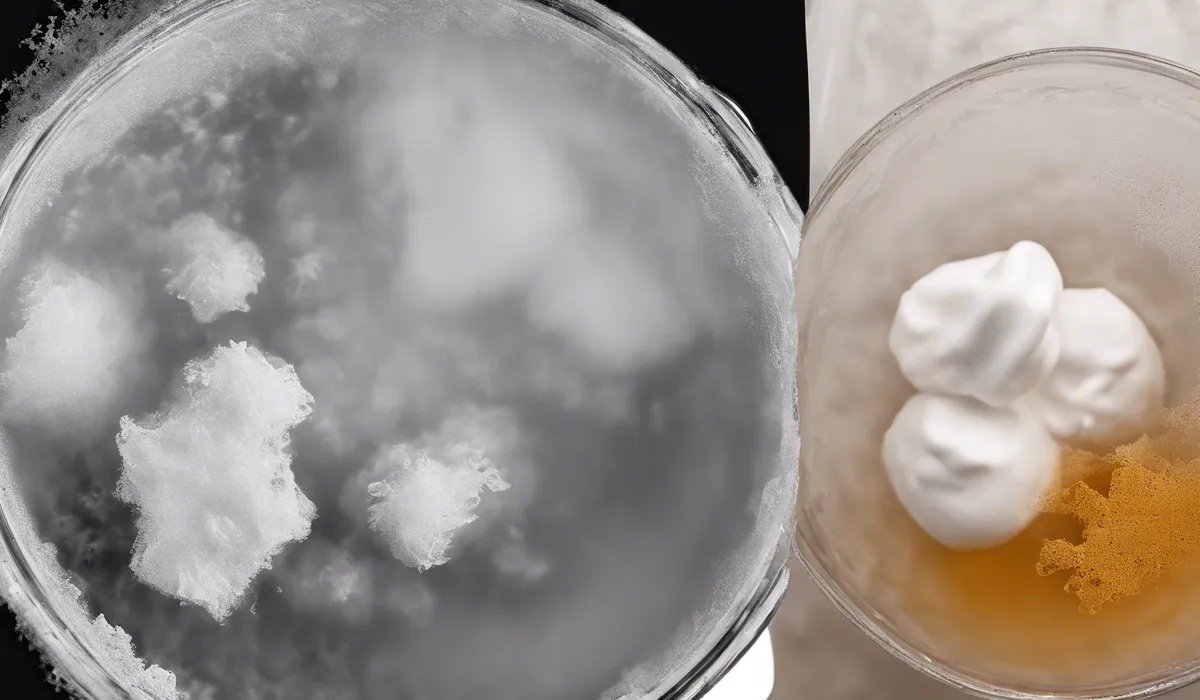Yes, vinegar and baking soda can kill mold. Vinegar is a mild acid which can kill 82% of mold species. Baking soda, used with vinegar, neutralizes odors and inhibits mold growth. Apply the mixture directly to the moldy surface and scrub away.
Science Behind Vinegar and Baking Soda as Mold Killers

Understanding Mold: The Persistent Fungus
Mold is a type of fungus that can grow almost anywhere there is moisture and organic material.
Tiny spores that float through the air can start colonies on surfaces, especially in damp and poorly ventilated areas. Mold can cause damage to your home and health problems if not treated.
Acetic Acid: Vinegar’s Mold-Fighting Ingredient
Vinegar is known for its natural cleaning power, largely due to its acetic acid content. This acid has antimicrobial properties that can kill bacteria and fungi, including many mold species.
When vinegar comes into contact with mold, the acid disrupts the life cycle of the mold, stopping its growth and spread.
Breaking Down Mold Structures with Vinegar
Vinegar can penetrate the cell membrane of mold, causing the cells to die. This penetration is critical in disrupting the mold’s vital processes, effectively killing it and preventing it from returning as long as the area remains dry and well ventilated.
Baking Soda: Alkaline Mold Inhibitor
Baking soda’s alkaline nature makes it an unsuitable environment for mold growth. Its mild abrasive action helps in scrubbing away the mold physically, while its ability to absorb moisture is vital in preventing mold from returning, as mold requires moisture to thrive.
Effectiveness of Vinegar and Baking Soda Against Different Types of Mold

Nonporous vs. Porous
Nonporous surfaces like glass and tiles are ideal for vinegar and baking soda treatments since they do not absorb the solution, allowing it to remain on the surface and work effectively against mold.
Porous surfaces such as wood may absorb the moisture, potentially feeding the mold instead of killing it.
Research Findings on Mold Remediation
Studies have shown that vinegar can kill up to 82% of mold species. Baking soda, while not as potent in killing mold, supports the cleaning process and prevents future growth.
Together, they create a formidable combination for mold treatment on appropriate surfaces.
Understanding the Limitations
Although vinegar and baking soda can be effective, they may not eliminate all mold species.
Some types of mold may require stronger agents or professional remediation. Knowing when to use this combination is key to effective mold control.
Environmental and Safety Advantages
Compared to harsh chemical mold removers, vinegar and baking soda are safer for the environment and the health of individuals using them.
They do not emit toxic fumes or leave harmful residues, making them a preferred choice for many households.
Practical Application and Safety Considerations

Creating the Mold-Killing Mixture
To start, you’ll need to prepare a mixture of vinegar and baking soda. Typically, you can apply white distilled vinegar directly onto the moldy surface and then sprinkle baking soda on top.
For larger areas, you might create a paste with a higher concentration of baking soda to spread over the mold.
Applying the Solution to Moldy Surfaces
Once you’ve prepared your solution, apply it generously to the moldy area. For hard surfaces, you may need to scrub with a brush. If you’re working with fabric, you might soak it in the vinegar and sprinkle baking soda directly on the stains.
How Long to Let the Mixture Work?
The duration the mixture should be left on the surface depends on the severity of the mold infestation.
Generally, allowing it to sit for an hour is sufficient, but for tougher mold, you may need to leave it overnight before scrubbing it off and rinsing the area thoroughly.
Handling the Ingredients Safely
While vinegar and baking soda are safer than many chemical alternatives, you should still handle them with care. Ensure the room is well-ventilated, wear gloves, and avoid direct skin or eye contact with the vinegar, as it can be irritating.
Preventing Mold from Making a Comeback
Prevention is crucial. Keep areas dry, use dehumidifiers if necessary, and ensure good air circulation. Regularly clean susceptible areas with vinegar to discourage mold growth, and immediately address any moisture problems, such as leaks.
Recognizing When to Call the Professionals
If the mold covers a large area or if you’re dealing with toxic black mold, it’s time to call in professional mold remediation services. They have the tools and expertise to safely and effectively remove serious mold infestations.
FAQs About Vinegar and Baking Soda Killing Mold
Can vinegar and baking soda be used together to kill mold?
Yes, vinegar and baking soda can be used together to effectively kill mold and inhibit its growth.
Is vinegar effective against all types of mold?
Vinegar is a mild acid that can kill up to 82% of mold species, but not all.
How do you apply vinegar and baking soda to moldy surfaces?
Apply a mixture of vinegar and baking soda directly to the moldy surface and scrub the area thoroughly.
Does baking soda alone kill mold?
Baking soda alone does not kill mold, but it can inhibit mold growth and neutralize odors when used with vinegar.
Can vinegar and baking soda remove mold odors?
Yes, the combination of vinegar and baking soda is effective in neutralizing mold odors.
Final Thoughts
Vinegar, a mild acid, effectively kills up to 82% of mold species. When combined with baking soda, it not only neutralizes unpleasant odors but also prevents mold growth.
Applying this mixture to affected areas and scrubbing can remove mold from surfaces, offering a simple and natural cleaning solution.
Useful Resources
- https://extension.msstate.edu/sites/default/files/newsletter/dawg-tracks-safety-talk/2016/dts_16_201606.pdf
- https://msdh.ms.gov/msdhsite/handlers/printcontent.cfm?ContentID=21043&ThisPageURL=http%3A%2F%2Fmsdh%2Ems%2Egov%2Fmsdhsite%2Findex%2Ecfm%2Findex%2Ecfm&EntryCode=21043&GroupID=44
- http://www.fsis.usda.gov/food-safety/safe-food-handling-and-preparation/emergencies/removing-odors-refrigerators-and
